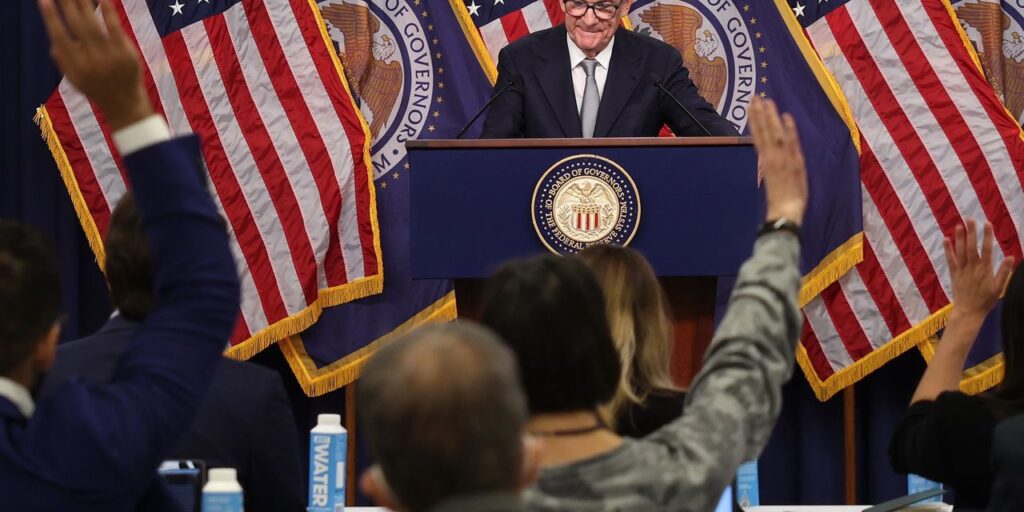“‘ With financial conditions, we’re looking for persistent changes that are material … Longer-term rates that have moved up, they can’t simply be a reflection of expected policy moves from us.’ ”
Federal Reserve Chairman Jerome Powell said last week that a sharp, recent increase in bond yields may be helping with his fight inflation, suggesting that the Treasury market could be doing some of the central bank’s work for it.
The problem is that Powell’s remarks appeared to then set off a power rally in stocks, while also sparking a sharp retreat in long-dated bond yields, which are used as a peg to finance the U.S. economy.
In other words, the bond market just demonstrated how quickly tighter financial conditions can come unraveled.
“It was a bit ironic that in touting financial conditions, Chair Powell undid some portion of the tightness we’ve been experiencing as of late,” said Mark Heppenstall, chief investment officer of Pennsylvania-based Penn Mutual Asset Management, which oversaw roughly $31.3 billion in assets as of September.
Powell’s remarks, offering some reassurance that the central bank could be done with hiking interest rates, prompted the bond market to continue pulling back last week from a recent steep climb in long-term Treasury yields. Two days after his comments, the 30-year Treasury rate
BX:TMUBMUSD30Y
ended Friday with its biggest weekly decline since March 2020. Meanwhile, the 10-year yield
BX:TMUBMUSD10Y
and the policy-sensitive 2-year rate
BX:TMUBMUSD02Y
respectively had their biggest weekly drops since March and August-September.
The moves illustrate the downside of relying too much on financial markets to do some of the Fed’s work, particularly as a way of avoiding future rate hikes.
Economists at Barclays
BARC,
said that the policy-setting Federal Open Market Committee is stuck in a “circularity loop,” with its intention of formulating policy based on tighter conditions undermining that very same tightness. They said developments since the Fed’s Oct. 31-Nov. 1 meeting “seemingly contradict” Powell’s comments that rising long-term yields matter only to the extent that they are “persistent” and not “a reflection of expected policy moves.”
Read: Treasury dealer still forecasts another Fed rate hike, but not until January
“There’s no doubt that the move higher in long-end rates is another form of tightening that’s happening, particularly in the mortgage market,” Heppenstall said via phone on Monday.
However, Heppenstall also speculated there might have been “something going on behind the scenes” that Powell has become aware of and investors are not, such as potentially more stress on banks. “His words weren’t really consistent with the message from the Fed’s statement, which came in hawkish.”
Last week’s drop in yields also may have been related to “offside positions coming back into the market,” Heppenstall said. Indeed, data from Goldman Sachs Group
GS,
and the Commodity Futures Trading Commission shows that heading into last week, hedge funds and other investors were likely surprised by the powerful rebound in stocks and bonds seen through Friday, forcing many funds to chase the market higher.
See also: Hedge funds left behind as stocks, bonds scored best week of 2023, data shows
On Monday, 2-, 10- and 30-year yields reversed direction from Friday’s session, by posting their biggest one-day jumps in roughly two weeks or more as traders priced in a 17.1% chance of a Fed rate hike by January. Meanwhile, all three major stock indexes
DJIA
SPX
COMP
managed to post gains after struggling to hold on to them.
At global investment manager Nuveen, which manages roughly $1.1 trillion in assets, Saira Malik, the San Francisco-based chief investment officer, said “the Fed left the door open to another possible rate hike before year-end — a stance consistent with its progressively upgraded characterization of U.S. economic growth, from ‘moderate’ to ‘solid’ to ‘strong’ in its past three policy statements.”
With third-quarter GDP growth of almost 5% and a 3.7% annual core PCE price index, “inflation remains squarely in the Fed’s crosshairs, even as markets expect the inflation rate to fall to about 2.4% over the long term,” Malik said in a weekly note.
Read the full article here











